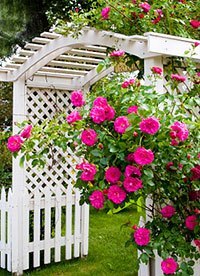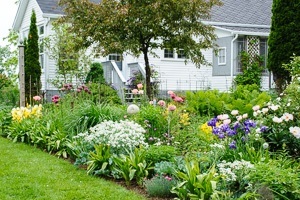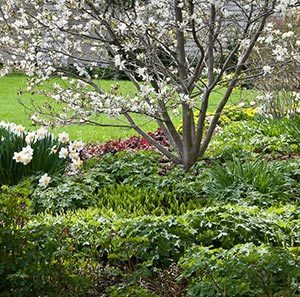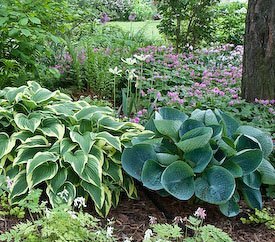Taking time to do some garden planning will help you tackle your back yard project with more confidence. Ask yourself the following questions:

This old-fashioned rose arbor suits a traditional garden style
1. What landscape design style do I like best?
Do you prefer straight lines or curves? A tumble of casual flowers or a more formal look?
Your house may provide a starting point for your garden planning. For example, symmetrical, formal landscape designs often suit traditional homes, while a country-style house with gingerbread trim would look romantic and lush surrounded by a colorful profusion of flowers.
On the other hand, a contemporary home may call a restrained Japanese garden design style, or the look of bold plants in large groups

Garden plan for small city yard
2. How wide should I make my flower beds?
When garden planning, beginners tend to make their beds too narrow because they’re intimidated by the task of filling them. Believe me, that’ll be the least of your problems — plants grow, and soon you’ll be moaning about the ones you don’t have space for!
Aim for a planting bed wide enough to accommodate three layers — front, middle, and back. A flower bed narrower than five feet won’t allow for the layering effect that gives a flower garden design the lush look you’re aiming for.
Beds that are more generous – six to 10 feet wide – look more spectacular. Here’s a simple principle to follow: the longer your bed, the wider it should be.
3. Island bed or flower border?

A cottage garden border of old-fashioned perennials suits this country cottage house very well
A perennial flower border is usually set against a backdrop — a fence, the wall of a house or garage, a hedge or the edge of your patio.
Borders tend to be more popular because yards are smaller these days, so setting beds along property edges makes for the most logical flower garden design.
Island beds generally are islands of flowers planted in a sea of lawn. They can look wonderful with taller plants in the middle and others arranged so they’ll look good from all sides — or they can resemble blobs of color washed up on the lawn. When they don’t look great, it’s usually because they are out of proportion, generally too small. Too often soil is piled up so high that they resemble a burial mound.
Avoid plunking an island bed smack-dab in the middle of an otherwise empty yard. Setting your bed off to one side of the yard or another is almost always better then putting it front and center.
4. What’s my favorite season?

This garden bed is at its best in spring with a star magnolia surrounded by bulbs and early perennials
Think about whether you want a garden that’s colorful all season long or just in certain periods?
If you always go away in mid-summer, consider a garden design that bursts with color from spring bulbs, early perennials and flowering shrubs, but that’s low-maintenance in midsummer.
When garden planning, aim for another peak of bloom in late summer, and be sure to plant a few shrubs and trees that provide great fall color.
If you mostly enjoy your garden after work and in the evenings, think evening-scented plants, light-colored flowers and consider adding garden lighting.
5. How much sun does my garden get?

Hostas, big-root geraniums, ferns and fringed bleeding heart enliven a shady setting
This a key to garden planning. Most flowering plants love full sun, which means they need at least six hours of direct sunlight a day.
Don’t despair if you have a lot of shade – there are lots of plants that love growing in shade. If your yard doesn’t get more than a couple of hours of direct sunlight a day or basks in dappled shade most of the time, choose plants for shade.
Many yards have areas of both sun and shade, so keep that in mind too when considering plants. Your garden plan should always take the amount of light into consideration. This makes a big difference to what will grow well for you.
More garden design tips
Flower garden planning tips: Bed width, spacing of
perennials, garden accents and focal points
Color in the garden: How you can create great color schemes
All-season bloom: Plant a garden that’s colorful from spring
to fall
Need landscape design help from a pro? Tips for hiring landscape
professionals
Do you have an acreage? How to plan your country garden design




